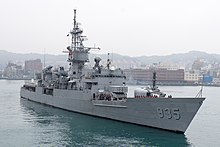USS Joseph Hewes (FF-1078)
 USS Joseph Hewes (FF-1078) | |
| History | |
|---|---|
| Name | Joseph Hewes |
| Namesake | Joseph Hewes |
| Ordered | 25 August 1966 |
| Builder | Avondale Shipyard, Westwego, Louisiana |
| Laid down | 14 May 1969 |
| Launched | 7 March 1970 |
| Acquired | 6 April 1971 |
| Commissioned | 24 April 1971 |
| Decommissioned | 30 June 1994 |
| Stricken | 11 January 1995 |
| Fate | Transferred to Taiwan |
| General characteristics | |
| Class and type | Knox-class frigate |
| Displacement | 3,211 tons (4,192 full load) |
| Length | 438 ft (134 m) |
| Beam | 46 ft 9 in (14.25 m) |
| Draught | 24 ft 9 in (7.54 m) |
| Propulsion |
|
| Speed | over 27 knots |
| Complement | 18 officers, 267 enlisted |
| Sensors and processing systems |
|
| Electronic warfare & decoys | AN/SLQ-32 Electronics Warfare System |
| Armament |
|
| Aircraft carried | one SH-2 Seasprite (LAMPS I) helicopter |
ROCS Lan Yang (FFG-935) is a Chi Yang-class frigate of the Republic of China Navy. She was formerly in service as the USS Joseph Hewes (FF-1078), a Knox-class frigate of the United States Navy.
Construction
Constructed by Avondale Shipyard, Westwego, Louisiana and laid down 14 May 1969, launched 7 March 1970, and delivered 6 April 1971. She was commissioned 24 April 1971, christened by Mrs. Caroline Groves Gayler.
Design and description
The Knox class design was derived from the Brooke-class frigate modified to extend range and without a long-range missile system. The ships had an overall length of 438 feet (133.5 m), a beam of 47 feet (14.3 m) and a draft of 25 feet (7.6 m). They displaced 4,066 long tons (4,131 t) at full load. Their crew consisted of 13 officers and 211 enlisted men.[1]
The ships were equipped with one Westinghouse geared steam turbine that drove the single propeller shaft. The turbine was designed to produce 35,000 shaft horsepower (26,000 kW), using steam provided by 2 C-E boilers, to reach the designed speed of 27 knots (50 km/h; 31 mph). The Knox class had a range of 4,500 nautical miles (8,300 km; 5,200 mi) at a speed of 20 knots (37 km/h; 23 mph).[2]
The Knox-class ships were armed with a 5"/54 caliber Mark 42 gun forward and a single 3-inch/50-caliber gun aft. They mounted an eight-round ASROC launcher between the 5-inch (127 mm) gun and the bridge. Close-range anti-submarine defense was provided by two twin 12.75-inch (324 mm) Mk 32 torpedo tubes. The ships were equipped with a torpedo-carrying DASH drone helicopter; its telescoping hangar and landing pad were positioned amidships aft of the mack. Beginning in the 1970s, the DASH was replaced by a SH-2 Seasprite LAMPS I helicopter and the hangar and landing deck were accordingly enlarged. Joseph Hewes had the first deployed LAMPS helicopter in the history of the Navy. Aft of the flight deck was an eight-cell BPDMS missile launcher for Sea Sparrow missiles, later replaced by Phalanx CIWS.[3]
Modifications
The USS Joseph Hewes (FF-1078) and subsequent ships of the Knox-class frigate class were modified to enable them to serve as flagships. The primary change was a slightly different arrangement of the "Officer's Country" staterooms with additional staterooms in a new 01 level structure which replaced the open deck between the boats. The stateroom on the port side under the bridge was designated as a "flag" stateroom, with additional staterooms for flag staff when serving as a flagship. These ships have been referred to as the Joseph Hewes-sub-class [citation needed].
Service history
On 15 February 1985, Joseph Hewes arrived to the scene where the M/V A. Regina, a passenger cargo ferry ran aground on a reef off Isla de Mona. Due to surf conditions, Joseph Hewes was unable to use its boats to transport the evacuees which had landed on the nearby island. Joseph Hewes remained on scene to assist and using its helicopter, delivered hot food, soft drinks, and water to the A. Regina evacuees on Mona Island.[4]


The ship was decommissioned 30 June 1994 and struck 11 January 1995. She was disposed of through the Security Assistance Program (SAP), transferred, cash sale, ex-US fleet hull foreign military sale, transferred to as Taiwan as Lan Yang (FF-935).
Awards
- Combat Action Ribbon
- Joint Meritorious Unit Award with oak leaf cluster
- Meritorious Unit Citation
- Navy E Ribbon (3 awards)
- Navy Expeditionary Medal
- National Defense Service Medal with bronze star
- Armed Forces Expeditionary Medal with two bronze stars
- Vietnam Service Medal with one campaign star
- Sea Service Deployment Ribbon
- Republic of Vietnam Campaign Medal
See also
Notes
- ^ Friedman, pp. 357–60, 425
- ^ Gardiner, Chumley & Budzbon, p. 598
- ^ Friedman, pp. 360–61; Gardiner, Chumley & Budzbon, p. 598
- ^ "Safety Recommendation" (PDF). www.ntsb.gov. Retrieved 18 February 2024.
References
- Friedman, Norman (1982). U.S. Destroyers: An Illustrated Design History. Annapolis, Maryland: Naval Institute Press. ISBN 0-87021-733-X.
- Gardiner, Robert; Chumbley, Stephen & Budzbon, Przemysław (1995). Conway's All the World's Fighting Ships 1947-1995. Annapolis, Maryland: Naval Institute Press. ISBN 1-55750-132-7.
 This article includes information collected from the Naval Vessel Register, which, as a U.S. government publication, is in the public domain. The entry can be found here.
This article includes information collected from the Naval Vessel Register, which, as a U.S. government publication, is in the public domain. The entry can be found here.
